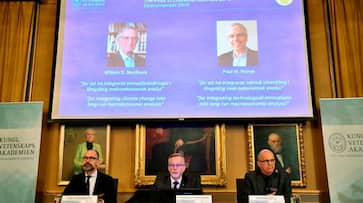Both the Americans worked towards integrating climate change and technological innovation into the macroeconomic analysis
Stockholm: William Nordhaus and Paul Romer were jointly awarded the Nobel Prize in Economics on Monday for significantly broadening the scope of “economic analysis by constructing models that explain how the market economy interacts with nature and knowledge”.
Both the Americans worked towards integrating climate change and technological innovation into the macroeconomic analysis.
William Nordhaus
Born in Albuquerque, New Mexico, Nordhaus completed his undergraduate work at Yale University and went on to complete his PhD in economics from the Massachusetts Institute of Technology.
He has been working on developing economic approaches to global warming since 1970s and developed the DICE and RICE models. He also integrated assessment models of the interplay between climate change, energy use and economics.
Nordhaus also wrote several books like Invention, Growth and Welfare, The Efficient Use of Energy Resources, Reforming Federal Regulation, Managing the Global Commons, Warming the World and Is Growth Obsolete? Jointly with Paul Samuelson, the 77-year-old economist wrote the classic textbook, Economics.
Paul Romer
Romer, who was born to former Colorado governor Roy Romer, completed his BS in mathematics and MA in economics in 1977 and 1978 respectively. In 1983 he also earned a PhD in economics.
In 1997, Time magazine listed Romer as one of America's 25 most influential people. He was also awarded the Horst Claus Recktenwald Prize in economics in 2002.
The 62-year-old is credited for showing how the willingness of firms to produce new ideas are driven by economic forces. He also formulated the endogenous growth theory, which can be considered as the foundation for a new model for development.
Last Updated Oct 8, 2018, 7:59 PM IST









![Salman Khan sets stage on fire for Anant Ambani, Radhika Merchant pre-wedding festivities [WATCH] ATG](https://static-gi.asianetnews.com/images/01hr1hh8y86gvb4kbqgnyhc0w0/whatsapp-image-2024-03-03-at-12-24-37-pm_100x60xt.jpg)
![Pregnant Deepika Padukone dances with Ranveer Singh at Anant Ambani, Radhika Merchant pre-wedding bash [WATCH] ATG](https://static-gi.asianetnews.com/images/01hr1ffyd3nzqzgm6ba0k87vr8/whatsapp-image-2024-03-03-at-11-45-35-am_100x60xt.jpg)


